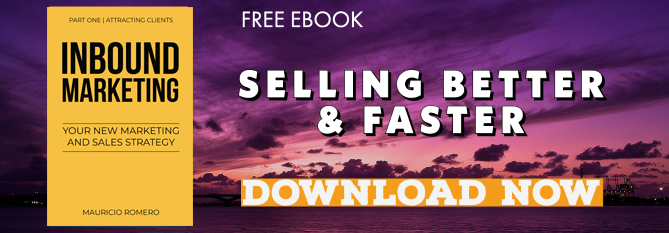Ever since 2010, we have helped companies in the implementation of their Inbound Marketing strategy. The hardest lesson that we have to learned, is that if the marketing strategy does not work hand in hand with the sales team, companies just won't close as many deals as they should. For this reason, the Inbound strategy had to grow and expand to the sales area as well. How does this process take place?

Leads Generation with Inbound Marketing
A well implemented Inbound Marketing strategy is always a success. It generates many leads and people interested in the content of the site. It is the most effective technique that I know to generate more prospects. But... generating prospects and leads doesn't necessarily mean that people are ready to buy. If these prospects don't receive proper nurturing and there isn't a sales team that will exclusively dedicate themselves to give these customers a follow-up, there will be NO SALES.
The process is simple, a prospect arrives to your site, downloads material that offers answers to the questions that he has, information about how to solve his problem or reach the opportunity he's been looking for. We are educating our client with content and he is learning more and studying his options.
Once he has downloaded a sufficient amount of content, we assume that he is ready to be contacted by someone of our sales team. With this, the marketing team that had been sending content to the client according to his preferences and context, will delegate this client to someone in the sales area, who will in turn, start a conversation with this prospect. It is at this point where most people don't know what to do. The salesman is willing to call and so everything it takes to close the deal yet, is the client really ready? Depending on the salesman approach, on the development of their talk and on the interest that the client shows, that the client will interested in following the purchasing process or not. It will depend on whether trust is generated or not.
Sales have changed and I will explain how they've changed in this article. This change is the reason why a sales methodology was developed to go with Inbound Marketing, the Inbound Sales Methodology.
What is Inbound Sales and What is it After?

What Inbound Sales pretends to achieve, is to make companies improve their relationship with the processes and to sell just the way people like to buy.
Sales today have to become increasingly human. The funny thing is that the process started with Inbound Marketing is based on a digital and impersonal approach; It might seem like an not-very-human process, automated by machines. Yet, the trust generated between the client and the salesperson is key in order to close a deal. This is the trusting relationship that we must go for instead of "playing games", like clients and salespeople usually do.
Inbound Sales Philosophy
Why do we say that clients and salespeople play? Because we've seen that the traditional sales vision and culture, at which the client and the salesperson are adversaries, still happens. Based on this traditional approach, only one of the two parties wins and the other one loses.
This is why all the traditional sales books and courses make analogies based on sports or on war. And good businesses, as I was taught at IPADE, my business school, are not like that at all. Good businesses are based on trust.
It is only based on trust that we can generate value and impact within an organization. This should be both the buyer's and the seller's common goal: to work together in order to make a change based on the solution that the salesperson is offering.
That's why if you want to make a good business relationship, sales and purchasing must switch from a vision of adversaries to a vision of collaborators. This is a fascinating concept mentioned by Ian Altman, I recommend you read one of his texts or listen to his podcasts.
The question that you may now have is: How do I generate trust and collaboration between buyer and seller? How do I close good deals and not only that, but also achieve good long-term business?
The answer is by changing the vision of your sales team and generating an intelligent, repeatable and scalable sales process.
Design of a sales process
After assessing many companies that we have worked with, we have realized that only few of them have a well-defined sales process. Their salespeople have no specific and clear steps to follow. Each of them does it it own way/style, they each "kill cockroaches their own way".
The job that the sales management team believe they have to do, is to write reports and to pressure their salespeople into reaching their sales quota.
And the organizations that we have worked with and that do have a process system, are generally not aligned with how their customers buy or how they would like to buy.
How does today's consumer buy?
The current buyer does not like to be sold to, he likes to buy. Buyers today have the upper hand. Yesterday, the one who had all the information was the seller but, in this information era that we live in, this has changed.
The current buyer is informed and does his research and evaluation process beforehand. He is looking to solve a problem he has and has evaluated several possible solutions. Only then, he decides on one of them. He evaluates his potential suppliers, selects one or two in order to compare them. And just until that moment, he gets in touch with the sales team.
And yet our old-school salesmen insist on pushing the sale and talking about how wonderful their company is as well as if the qualifications, skills and abilities of its employees.
Pushing a sale is an ethical problem that brings future problems
Imagine that you have been given a product or service that you don't need and even made you pay for it. How will that seller-buyer relationship be in the end?
How about when a salesman offers the same solution that he's given to other customers to new customers that don't really need it? How will that work out?
It is not about the salesmen and their quota, it is about the buyer's problems, what the latter is trying to solve. Which is why, from the very beginning, the sales pitch and the presentation of the solution should be aligned to the buyers needs and to the specific solutions to their problems.
Together, they should focus on seeing if they can generate value and impact in the organization.
Align the sales process to the buyer
In most cases, the sales process is not aligned to the buyers needs. There are many gaps that have not been filled with the buyer's doubts. If you don't make an analysis about how the buyer is making his decisions, about the fears he might have related to making business with a company, you will have several problems:
- Your buyer won't understand the value of what you do. Thus, he won't be willing to consider your solution. Or, he will be a buyer whose criteria will be based on the price: If we don't value something but we indeed need to solve a problem, we'll be willing to pay but just very little for it.
- He won't understand the impact that your solution might bring. If he sees the value of what you do but the impact is not enough, he will look for a different solution, one that would make more sense to him. Or he'll just leave things as they are.
- He will object. The objections always come at the end of the purchase process or even worse, when the service is being delivered. It is at this delivery moment that a customer may ask for service "cuts", cancellations, or even sue the company. All because we didn't address specific concerns on time and left our customers misinformed. He will only see unpleasant and unexpected "surprises" and thus, we will only generate distrust on him.
All of these problems can be avoided by aligning the buyers and sellers processes. This is why it is very important to know at what moment does each topic is addresses in a process, even when the buyer hasn't even mentioned it. It is all about sharing value and looking for impact together.
Whenever we assess our clients, we carry out this thorough process about the needs and doubts that our ideal buyer may have and about the regular sales process of the organization, so we can later bring them together and discover and generate value and impact.
Evaluation process of a prospect
One of the key assets that we must always apply in a sales process, is to provide our sales teams with a methodology that will help them evaluate and understand the client that they are getting involved with, so that they can weigh and consider the best way to go, based on reliable information.
Evaluating prospects is one of the most important assets of the sales activities. The seller must seek to strengthen a good long-term business relationship and to generate impact on the buyer's organization. You must not push the sale.
When salesmen get involved with a prospect that is just not the right fit, many future problems may happen. For example, a sale will be closed but in the end, the client will not be satisfied, or you, as a provider, won't be satisfied either and won't want to work with the client. Long story short, the two parts involved just won't be comfortable. This is a "best case" scenario, the worst case scenario would be when your salespeople invest a lot of time and effort in closing the deal just so that in the end, it never happens.
Sometimes it is better to just not work with some clients:
- When he doesn't recognize the value of your service
- When he doesn't need your service
- When he can't pay for your service
- When he is not a fit with your company's values and culture
One of the biggest sales mistakes that you can make, is to believe that you can sell what you do to all of your prospects.
This is why we strongly advise our clients to have a very clear idea of who can your organization actually help, who is your ideal client. Not just any customer, you want to know who is the ideal customer, the one that will need and value the services that your company offers.
If you don't have a clear idea of who your ideal client is, of his specific characteristics, and of how can you generate value for him, your sales teams will fall into a lack of productivity and effectiveness. This is why only 34% of sales agents reach their quota.
Another problem that we might face when not being clear about the evaluation process, is to engage on sales processes that last longer than they should. This usually happens because we have not understood the importance of implementing the solution along with the client. If the client considers that it is not a priority to solve his problem with your solution, the sale may take a long time.
Another way to make a sale last forever is by not talking to the decision makers. If your salespeople don't evaluate this, the process can take a long time or you might even lose the sale because you didn't share the value correctly, to the right person. We all usually deal with a person who will summarize our solution to their boss (the actual decision maker), and only god knows how the idea that we presented will be shared with him.
We want our salespeople to close sales as quickly as possible and to the right prospects. Evaluating your prospects can help your salespeople become more effective.
Inbound Sales Process
Just like Inbound Marketing follows specific steps, the Inbound Sales process follows the following 4 steps:
1.- Identify your prospects and potential clients
In this stage, while the salesman is prospecting, he should dismiss those prospects that are not just buying. He should focus on companies who are growing and are actively looking for solutions. The good news is that all the clients that come to us via Inbound Marketing, are already looking for a solution to their problem via internet.
With traditional sales, salesmen usually get these clients database and start calling each one of them, regardless of how willing they are to buy buy anything. This only makes your sales force loose valuable time with clients that aren't currently looking to buy anything.
2.- Connect with your prospects
As we've mentioned before, if a seller pushes a lot, specially by using the traditional process of cold calling, the buyer will understandably resist and won't want to know a single thing about us.
Therefore, once we have identified an active client, one who has actually shown some interest in solving their problem with our solution, we should always approach, contact and relate to this client in a more subtle way, not pushing things.
During this stage, a traditional salesman would start cold calling everyone and just repeat on every call a memorized message, regardless of each client's personal needs. Most likely, these people aren't even looking for that service, they are not active.
We have all received that bank's call or that salesmen's call in which we are just not interested at the moment, so we are just being interrupted by them in a usually very intrusive way. This is what we now call SPAM. A kind of communication that we are not interested in, we didn't ask for and is only interrupting us.
The right way to sell is very simple: we should contact the person once we are familiar with his context so we can personalize our sales pitch to his needs. We've said it before, this isn't about your abilities and qualifications, it's about the buyer's needs.
3.- Explore the sale with your prospect
In this stage, a traditional salesman would make a one-fits-all presentation that he uses with every client. In this presentation, he will talk about how great his company is. Aren't this presentations a little boring? They add no value.
On the other hand, an Inbound salesman looks for a way to generate value along with the buyer. He explores the problem with the buyer, it's importance and impact. At the same time, he keeps evaluating the client's needs.
4.- Advice your prospects and offer solutions to them
During this stage, a traditional salesman would present a quote, a formal proposal, a contract or solution. We could say he is in an auto-pilot stage, he still adds no value.
A modern salesman personalizes the proposal and adapts it to what the client really needs. He doesn't give him unnecessary "accessories" and focuses on generating value and on the impact that his solution will bring.
He also advises clients on how they should get from point a to point b in order to get the best results. It actually turns into a small free-consultancy meeting. All with the intention to show the impact that you have to offer.
If this process is designed well, then this whole effort will turn into a sale.
Scaling the Sales Process Up
The main benefit of an Inbound sales process is being able to upscale it. In other words, we can make our sales team grow in order to make it more effective thanks to the clear and easy-to-follow processes that any salesmen can follow and repeat from one stage to the other.
As you can see, creating modern sales teams implies applying a whole new strategy behind it. It also implies a change of philosophy that goes from adversaries to collaborators (between buyer and seller). Much of the strategy's success lies in the design of these processes. It is not a simple path, but it will give us a well-defined sales process.
For all of these reasons, we at DataBranding help our clients during the implementation of this Inbound's second phase by means of training courses, at which the participants get to know all about the best practices for this methodology.
This is the first part to do Inbound Sales. We still have to talk about the design of a sales team, which we will discuss in another article.
If you would like to know more about the Inbound Marketing strategy, download our free e-book:

 Paulina Romero H
Paulina Romero H